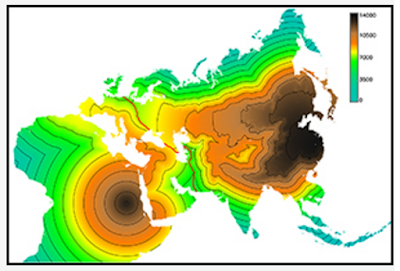Abstract:
"Where did pottery first appear in the Old World? Statistical modelling of radiocarbon dates suggests that ceramic vessel technology had independent origins in two different hunter-gatherer societies. Regression models were used to estimate average rates of spread and geographic dispersal of the new technology. The models confirm independent origins in East Asia (c. 16000 cal BP) and North Africa (c. 12000 cal BP). The North African tradition may have later influenced the emergence of Near Eastern pottery, which then flowed west into Mediterranean Europe as part of a Western Neolithic, closely associated with the uptake of farming."
What's interesting is that by "North Africa" they actually mean "Northeast Africa" as the map above implies and they make clear here:
"Early Holocene pottery sites are found within a 4000km-long band encompassing the southern Sahara and northern Sahel, with early dates clustering in the Middle Nile valley and the Western Desert of Egypt, in the vicinity of the mountainous regions of southern Algeria and northern Niger, and at Ounjougou, Mali (Close 1995; Nelson et al. 2002; Jesse 2003; Huysecom et al. 2009).....
A number of locations inNorth Africa have sites with pottery dated to the earlyHolocene. Ounjougou, in Mali, has some of the very earliest dates but lies quite distant from the Near East (Huysecom et al. 2009). Pottery that is potentially as early as the Ounjougou material has been found at sites that are geographically closer to the Near East. Bir Kiseiba, in theWestern Desert of Egypt, has the earliest dates coming from site E-79-8, although with large margins of error, and in the central Nile Valley of Sudan, the Saggai site has produced the region’s earliest date for pottery (Close 1995)... We have taken... Saggai in Sudan (e.g. Caneva 1983) as the origin point in Africa. The exact location of the source point in the broader region of origination is unlikely to significantly affect the modelled results.."
I imagine these early potters, given the early dating, would've been pretty similar to modern Dinkas from an autosomal DNA perspective, just discounting the West-Central African-related ("Yoruba-like") elements in them. Some West Asian input is possible, I guess, but I somehow doubt it. Just my opinion on the matter from a genetic stand-point.

This supports the theory for Christopher Ehret who theorized over a decade ago that the origin of the pottery tradition in the Near East and Europe originated on the Nile Valley in Africa. Glad there is now empirical data to support this.
ReplyDelete